Autumn Visions/Which Computer Platform?

Thank you for your generous contributions. We're slowly collecting enough images to make the mosaics. I realize I'm posting the same paragraph each week, but I assure you we're on top of this project and doing our best to collect enough of the proper type of images to make the best possible set of mosaics. This is proving difficult so please help if you can.
We are still accepting (and pleading for) images of children from SEA. No matter how terrible you think they are, please send them in anyway. These images will be used to complete a set of 3 high quality mosaics which will be sold to benefit the Karen and Burmese Orphans living in the orphanages and refugee camps. The more images the better, I can use all you have. Please take the time to go through your images for anything you think might help. If you missed the "No Place to Call Home" special, you can click on the link and read more about this. Thank you! QandA@Bkkimages.com
Feature Photograph

Nikon D100, Nikkor 28-70mm F2.8 AFS @F8
Autumn was always my favorite time of year and it took on new meaning when I started to be involved with photography. When I lived in the Pacific Northwest (Oregon specifically) I started keeping a calendar
showing when certain trees would turn color, when certain fruits would no longer be available, and even when the streams and rivers would increase their flow due to more frequent rainfall. I'd use this information to carefully plan available
weekends so I could be sure to be in the most beautiful areas at the perfect times.
It's hard to describe the northwest to someone who has never been there but I'll try. Have you ever been in a Christmas tree lot and the smell of Christmas trees would be overpowering? The northwest is like this. Christmas trees are evergreens
which means they stay green all year. Evergreens are everywhere in the Pacific Northwest. The Pacific Northwest is where the bulk of the worlds Christmas trees and cut lumber are grown. I used to walk outside the backdoor with my sons, walk among
the forest until we found the perfect tree, and together we'd cut it down and bring it home. They never knew it, but we always took the long route. The route that took us over a rushing creek via cable bridge, up a mountain, through several
meadows, into a dense forest, until finally we'd find the perfect tree. It was a huge circle, an excuse to spend time outdoors with my sons. The distance from where we'd cut the tree to the backdoor was less than 200 yards. To them it
was a great adventure and we had to trek over five miles to find the perfect tree. We did trek five miles, just mostly in a circle.
Thailand has seasons, subtle in their gentleness we're often unaware a season has come and gone unless reminded by tepid humidity or spectacular monsoon season thunderstorms. Still, sometimes I miss the Pacific Northwest and my favorite season Autumn,
and with Halloween being today and Thanksgiving just three short weeks away, I thought I'd run a special weekly sharing images I was able to salvage after the big RAID crash of a few years back.
The above image was my favorite fishing hole. It was less than 150 yards off our deck. The creek is Hubbard Creek. The trees would turn a delicious symphony of red and yellow hues and I'd stand there on the rocks with water splashing at my feet and
my sons casting to just the right spot to entice a rainbow trout. The serenity and occasional explosive excitement of a trout striking made for the best of memories. This image is significant because it visually represents the beauty and emotional
harmony of these moments. Sometimes on rare occasions, life can be perfect.

Nikon D100, Nikkor 28-70mm F2.8 AFS @F5.6
Who's going trick or treating this evening? A costume party perhaps? I'm afraid if I knocked on my neighbors door here dressed in a Sinbad Sailor Costume with a lighted pumpkin shaped bucket and screamed "Trick Or Treat" they'd
call the boys in brown and lock me up. I made this capture years ago, again close to my home. Staring at it I thought if only.. so I cut the tree in half vertically and then mirrored the remaining side to the other.. and there they were. A series
of scary faces. Can you see them? A big scary rabbit face in the center, a small gorilla above him, and below a giant spider! Can you see them too or am I just crazy?

Canon 1d Mark II, 24-70mm F2.8 @F8
Above is how your Thai spouse might dress on her very first Halloween! Halloween etiquette dictates that if you leave your front porch light on, that you have candy for the trick or treaters. The wife had a grand time dressing up and handing out candy.
Autumn Visions

Canon 1ds Mark II, 24-70mm F2.8 @F5.6 1/40th ISO 100
Most of the time the way we see Bangkok could just as easily be in black and white. Cement structures, few trees, and hazy pollution filled skies. Noise is everywhere, from the sounds of the road with buses motoring and horns honking, to the constant
chatter of the residents raised in volume to compete with the perennially loud televisions and music players. Sewage and raw garbage are most often the strongest smells, thankfully dulled by the sharp aroma drifting from the skillets of the food
vendors. Bangkok isn't just a city. Bangkok is a lifestyle. Bangkok provides life to the masses while often eating it's young. Only the strong survive.

Canon 1d Mark II, 24-70mm F2.8 @F4 52mm 1/30th ISO 100
In Oregon one of our favorite outings was to Mill Creek Falls and the Avenue of Boulders. This was a day outing often planned in advance, but sometimes an afterthought. Weather dictates desire. Desire motivates. We'd spent many hours hiking these
trails and taking in the natural beauty of Oregon's Rainforests. Desire satisfied.

Canon Mark II, 24-70mm F2.8 @F4 1/250th ISO 100
From a vantage point several thousand feet up a trail we would gaze down on the falls as they descended hundreds of feet in a freefall of rushing water before crashing into the river below. During the fall season deciduous trees would show their Autumn
colors revealing their secret locations hidden among the evergreens. From this redoubt a strong cold wind drives through your windbreaker reminding you winter isn't far behind.

Canon 1d Mark II, 24-70mm F2.8 @F4 55mm 1/30th ISO 100
My son armed with a camera and his stepmom would pose and make sure I took their photograph. Something about the biting cool fresh air, sounds of nature, and smells of the season would make them happy and playful.

Canon 1d Mark II, 24-70mm F2.8 @F8 24mm 1/15th ISO 100
Once you leave the car the immersion is immediate. 10 meters from the car you can no longer see it, the sounds of the occasional vehicle traveling the main highway is muffled and soon you don't hear anything. On this day the trail is wet from fresh
rain and a bit slick underfoot. The smell of evergreens is stronger than normal, mixed with the smell of rain you enjoy the best of natures fragrances. It's almost impossible to walk without reaching out and touching the wet moss on the rocks,
or the slick trunk of a Pacific madrone (medziesii) tree with it's orange hued bark and edible berries.

Canon 1d Mark II, 24-70mm F2.8 @F3.5 25mm 1/30th ISO 100
Nature is perhaps the most talented artist known to man. We just have to be brave enough to acknowledge that which has been created and put under our care. It's late fall and increased rainfall prompts furious growth of the mosses which appear to
be everywhere Boulders are carefully placed as if naturally sculpted and between them bright yellow wild flowers come to life, as much in contrast with the timing of the seasons as their color. Round boulders everywhere, vertical trees. Who was
the genius who placed the fallen madrone in the most perfect location?

Canon 1d Mark II, 24-70mm F2.8 @F3.2 24mm 1/80th ISO 400
I've spent too long peering through the viewfinder so my son takes it upon himself to backtrack and see if I've fallen over the side or perhaps fell asleep under a tree. In the context of nature I notice he looks so small and his choice of colors
are his only defense from blending in and disappearing forever. His presence competes heavily with nature for making this the perfect day.

Canon 1d Mark II, 24-70mm F2.8 @F8 24mm 1/13th ISO 100
Further down the trail the silence of the rainforest is broken by a dull roar. The further you go the louder the roar. Soon you notice a fine mist hanging in the air and suddenly you notice through the almost translucent leaves the river. The river runs
over the rocks carving its legacy into the earth in increments of time. To the side exists a still pool of water. Kneeling I run my hand to the bottom of the pool and bring up a small handful of pebbles and sand, each with their own story of purpose
and creation. The sands of time. I move on.

Canon 1d Mark II, 24-70mm F2.8 @F4 45mm 1/50th ISO 400
Now they're both looking and wondering what's keeping me. It could be argued their youth and fitness allow them to cover the ground much faster than myself, or that perhaps my age and experience just allows me to see far more than they're
yet capable of seeing. I want to take everything from this day possible. Nothing must be missed. Patience son, patience will be yours in time.

Canon 1d Mark II, 24-70mm F2.8 @F8 24mm 1/13th ISO 400
One of the more difficult descents. Slippery wet moss covered boulders, layer upon layer of slick red leaves, and two pairs of eyes watching from below. I'm thrilled to be up to the challenge. How small they look against the scale of the forest.

Canon 1d Mark II, 24-70mm F2.8 @F8 24mm 1/13th ISO 800
At the bottom of the small canyon we continue. We have several more miles to go and less than an hour of light to guide us. I'm already shooting at high ISO's and slow shutter speeds using natures trees and big boulders to brace. In this image
my right shoulder is leaning against a huge boulder, but my feet are fighting for traction with the slick leaves.

Canon 1d Mark II, 24-70mm F2.8 @F8 24mm 1/13th ISO 800
This is beautiful! We're outdoors, but it's like this small placement of boulders creates a separate room. The scale is hard to show in this image, but consider the boulder I'm leaning on to my left towers above me.. and is smaller than
the boulder in the middle of the frame. Isn't it grand that someone was thoughtful enough to place a footpath exactly where I'd need one to be?

Nikon F5, Nikkor 50mm F1.4 @F8 Fuji Velvia 50
This is old ASA 50 Velvia stock in my Nikon F5. It's early morning and I'm on a walk from the house. The sun has just come up over my shoulder. With slide film the exposure must be perfect. I take the time to spot meter several parts of the scene and then carefully select my aperture and shutter speed. At ASA 50 and because it's early morning the shutter speed is extraordinarily slow. I breath in slowly and exhale halfway. Bracing against a rock I gently press the shutter release. Another moment in time is captured on my favorite emulsion.

Nikon F5, Nikkor 45mm F2.8/p F8 Fuji Velvia 50
I either walked or drive by this house every day. From the road it appears to be a small house, but it has five bedrooms and 3 baths and a large barn you can't see. Behind the house is a large creek. On the other side of the creek the Douglas Fir
trees extend to the near ridge and beyond into BLM land. National Forest behind me. Only certain sections of this wilderness can be privately owned and I feel privileged to have lived here. The afternoon light falls over my shoulder onto the house
and season turned trees creating an image rich in color, but even more splendid in location.

Nikon D100, Nikkor 28-70mm F2.8 AFS @F5.6
The closest town was 17 miles distant. One two lane road winds through the canyon with a mountain on one side and a river on the other. The speed limit is reasonable in the best of weather, deadly in the worst. 17 miles of unspoiled beauty. I made this
drive at least once per day, sometimes twice. I rarely grew tired.

Nikon D100, Nikkor 28-70mm F2.8 @F8
Off the rear deck you could see five different types of apple trees. Whoever originally planted them was a genius. One type produced apples as early as March, while the last type to produce would have enough apples for Christmas pies. In this area deer
are often regarded as pests. They run out in front of cars causing a great many accidents, and have even been known to jump across the road from a higher vantage point and end up coming in the windshield with tragedy being the only possible outcome.
Every hunting season the hunters would come in their loud trucks and brash ways, harvesting any deer unlucky enough to be in sight. Sometimes they would strip the fillets right there and leave the bulk of the carcass by the side of the road to
rot. My place was a sort of refuge. They'd come to eat apples and the hay I'd put out for them during the winter. They'd graze with the llamas and even my Aussie's were accepted. I used to greatly enjoy sitting on the deck
and capturing them on film.

Nikon D100, Nikkor 28-70mm F2.8 AFS @F8
This is a yearling. Notice the nubs where the antlers will someday form? He's yet to show the scars from rutting and fighting, yet he's ever cautious and observant.

Nikon D100, Nikkor 28-70mm F2.8 AFS @F8
I noticed many tufts of fur left on the wire, tufts of deer fur. Often when I was home I could see them looking in from the nearby tree line, noticing the fallen apples. I'd open the metal gate and go sit on the deck and they would walk in through
the open gate and avoid scarring themselves. Open wounds in these conditions could easily become infected.

Canon 1d Mark II, 85mm F1.2 @F8 1/100th ISO 100
The rose hybrids would be the last to go. Autumn would just start to turn into winter, often the first layer of snow blanketing the ground. The roses would wilt, their thinner than paper petals each turning brown and curling at it's own pace. Already
too cold for the insects to be a problem like they are in the spring. The amount of detail available in a rose petal is extreme.

Canon 1d Mark II, 85mm F1.2 @F8 1/100th ISO 100
This is a crop. Really, not bad for an antique 8mp DSLR. The detail is revealed layer after layer.

Canon 1ds Mark II, Sigma 12-24mm F4 @F8 1/80th ISO 800
Thailand isn't without it's own fall colors, you just have to get out of the city and go look for them. Both the similarities and contrasts between the Pacific Northwest and Thailand can be startling. Here near the Khao Yai National Forest a
field not that different from my own back home.

Canon 1ds Mark II, 70-200mm F2.8 IS @F5.6 1/200th ISO 200
Once inside Khao Yai National Forest there are many animals to greet you. This monkey and her offspring clinging to her belly watch us with interest. Many of the trees in Khao Yai turn their fall colors.

Canon 1ds Mark II, 70-200mm F2.8 IS @F8 1/30th ISO 200
A single turned leaf. A sign we're either a few weeks early, or we've arrived exactly on time. It's a matter of perspective. An entire frame of red leaves would have been boring, but a single turned leaf, perhaps the very first leaf to
turn in the entire forest, standing alone beside millions of others.. yet to follow. One red leaf leading millions. Yes, the perfect time to be here.

Canon 1ds Mark II, 70-200mm F2.8 IS @F5.6 1/30th ISO 400
A welcome splash of color this early in the season. This guy watched my every move from the moment I exited the car, to the moment I drove away. His human like eyes followed my every move, growing concerned when my camera tracked the females with babies,
but always in control. The alpha.

Canon 1ds Mark II, 70-200mm F2.8 IS @F5.6 1/80th ISO 200
This guy is blowing a kiss goodbye. I hope you've enjoyed sharing some of my fall images. It's that time of year right now! As you read this it's Autumn in Thailand. Plan your own outings and share your images. You'll be glad you did.
Which Computer Platform?
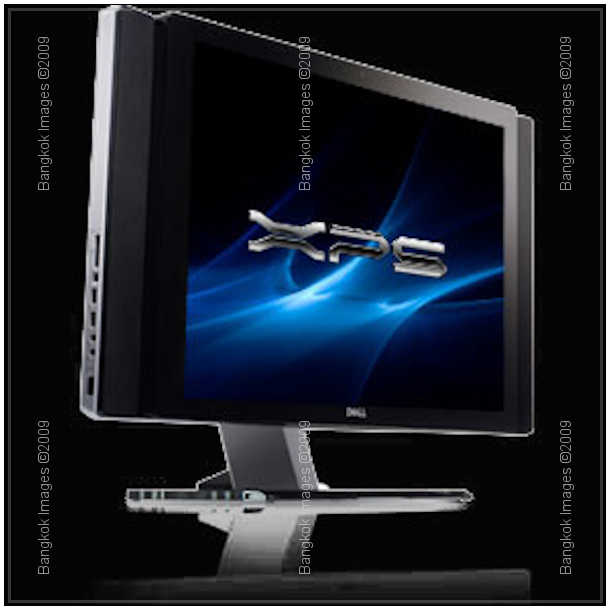
Dell XPS AIO
Two Main Choices
- PC Windows
- Mac OS/x
PC
There is no doubt that the overwhelming number of computers out there are Windows based PC's. PC hardware is made by hundreds if not thousands of vendors and you can either buy from a dizzying array of ready built machines, or you can build your
own. You can build a super small machine, or a large multi-processor machine that holds over 20 hard drives. With PC's you can have it your way. You have choice.
Choice means competition and competition drives the price down. PC's come in different qualities, from high end server grade components to low end consumer grade, and everything in between. You can pick and choose that which best fits your needs
and budget. Complete computer systems are available from approximately $300 for both a laptop or desktop, to well over $10,000.
PC's use the Windows Operating system. In most recent past use is the XP and Vista versions, and most recently (this week) an all new Windows 7 which promises real improvements over the previous two versions. All three versions are available in x32
and x64 versions. (32 and 64 bit processing)
Do you want a laptop, a desktop, or perhaps a new AIO? (all in one)
Laptops are replacing desktop computers at a ever increasing rate. People love the small footprint, low noise, more portability, less power consumption, and perceived simplicity of having an entire system in one enclosure. Laptops now have more than enough
processing and storage capability for your average user. Laptops also usually cost more than desktops for a given level of capability.

Dell XPS Studio 16
Desktops take up more room, are less portable, use more power, make more noise, and appear more complicated.. but they are without a doubt much more powerful and configurable in every way. Desktops get the job done.

Dell Precision Workstation

Dell Precision Workstation
AIO's are a cross between a laptop and a desktop. There is a monitor component which houses the hard drive, optical drive, and CPU, and then there's the wireless keyboard and mouse. It makes for a very neat and compact footprint that looks stylish
in the process. There is no big CPU box, nothing that makes a lot of noise, and they tend to use less power than most desktops. Their computing power comes from laptop CPU's and components which limits their processing ability, but they should
be fine for the vast majority of users.

Dell XPS Studio AIO
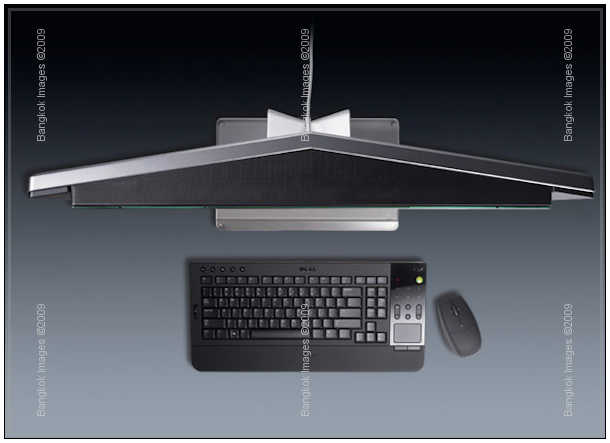
Dell XPS Studio AIO
Mac's
Mac's use the OS/x operating system with Snow Leopard being the newest. Snow Leopard is finally a x64 (64 bit) OS. Snow Leopard will not work with the older Power PC processors, only the newest Intel
based processors.
Mac's look great! There's no denying they're one of the best looking personal computers out there in all three formats. Apple takes a lot of pride in maintaining cutting edge style and performance.
Mac computers are only available from Apple. You can have whatever you want, any configuration you want, as long as its one of the few models Apple sells. This means you are severely limited in your choices. Apple sells Mac's, no one else does.
The good news it that most Mac's are quality built machines. Perhaps not on the highest end of quality, but certainly up there. Apple makes enough configurations so that most needs of most people can be satisfied. No, you can't custom build
anything you can dream up, you can only buy a configuration someone else (Apple marketing) thinks you'll need. Fortunately they're right most of the time.
Mac also upgrades it's line regularly. New and improved models are released often.
Mac laptops come in three versions, a "Macbook Air" lightweight model, a "Mac Book" general model, and "Macbook Pro's" for those who want the most performance and features.

Mac Book Pro
There is only one desktop and it's the Mac Pro. Really, it's a work of art. It comes with up to two physical CPU's and is quite powerful. Unfortunately the case size limits how many internal hard drives it can hold.
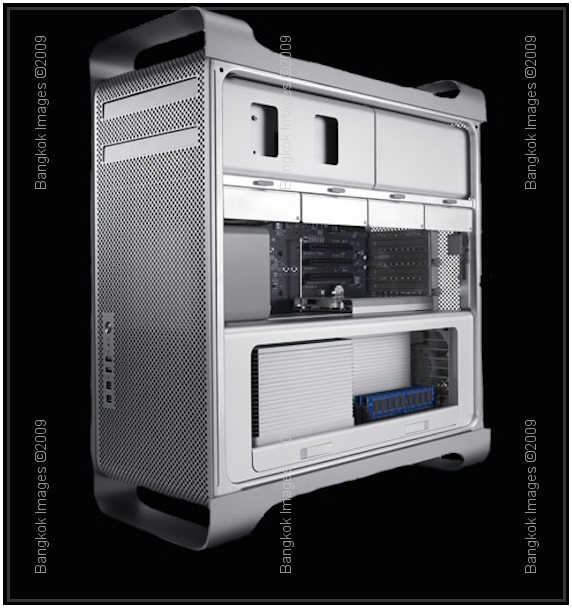
Mac Pro
Extremely popular are the Imac's. These AIO's have a great design and Apple in fact invented the AIO genre. Laptop power, hard drive, and optical drive, all housed in the monitor housing with a wireless keyboard and mouse. Wonderful machines.
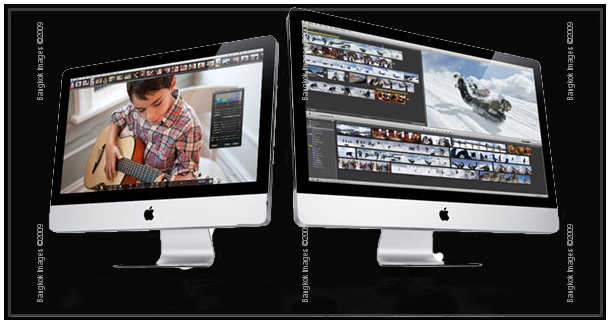
Imac
And then there's the unique "Mini Mac" which is about as big as a cookie box and houses a hard drive, lower powered CPU, and drives a regular monitor, keyboard and mouse.
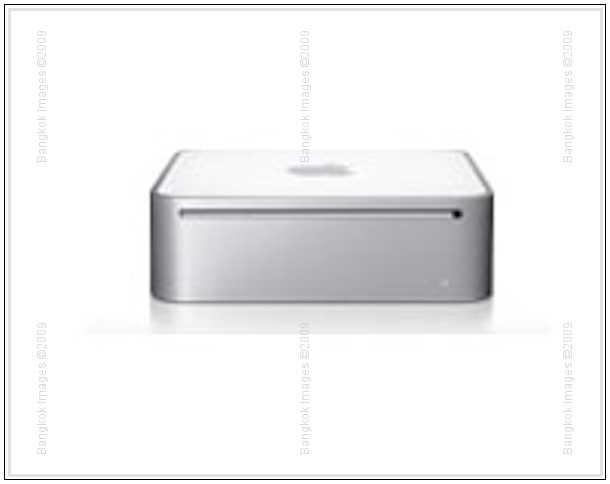
Mac Mini
Because only one company (Apple) makes Mac's there is no competition other than from Windows based PC's. The price points of Mac's reflect this.
Operating System
OS/x or Windows? We've all seen the commercials. So which one? OS/x is slick, but the new Win 7 appears just as slick.. really I think Snow Leopard OS/x and Windows 7 are both very good operating systems, easy to use, reliable, and either one will
serve you equally. I couldn't say this a week ago. A week ago Windows 7 hadn't yet been launched and PC users were limited to XP or Vista. XP is long refined, but dated. Vista had a lot of teething problems when it was introduced but
is now a mature reliable product. OS/x Snow Leopard and Windows 7 are the two newest versions and I think either one would serve you fine.
It comes down to applications. OS/x comes with some very cool software, they seem tuned in to users better than windows and offer unique capabilities in their included applications which are more "cool" than those in Win 7.
Win 7 however has hundreds if not thousands of times more software written for it. If you need a unique application chances are you'll find it for Windows before OS/x. If it's a popular application however, there is probably a well refined OS/x
version with cool features.
Which One is For You?
The debate of the century. I don't think you will go wrong with either. I would say sit down and carefully write down your hardware requirements. Ask yourself if there is a Mac that meets these requirements. If there is, note the price. Certainly
there will be a PC configurable for whatever your requirements are, probably for significantly less money.
Now, make a list of the software applications you require. Use your search window and read reviews on both OS/x and Windows applications which fit your needs.
It's that simple. It depends on your needs. If there isn't a Mac which meets your hardware requirements, or it does but is priced much more than a PC, then go with a PC. If the choice still isn't clear, look at the software requirements.
Go sit down in some computer stores and ask to test drive both the hardware and software. Apple stores are great, PC stores vary depending on manufacturer. Perhaps in your local area one will be better than the other. Customer service and support
counts, and should factor significantly into your decision.
I'm not going to say one is better than the other. Because it's impossible to say this. Chances are one will fit your needs better than the other, but you personally will have to figure this out. If you let a cool design or fast talking salesman
decide for you, you'll probably be disappointed.
What do I use? I have Windows based machines. My requirements can't be met by a Mac. However, my requirements are far from average. We'll be bringing you some laptop and desktop reviews soon.
I hope this helps..
Photography News of Interest
In this column I've always highly recommended buying ONLY the best flash memory cards. There are only two companies I'd personally use, Lexar and SanDisk. Lexar just announced
their new 600x CF Card with capacities up to 32gb and a reader to go with it. Data transfer speeds up to 90mb/s make this their fastest card yet. This is roughly 3 times faster than what
was available on the market only a year ago. You can read more about ithere.
Canon 5d Mark II owners should take note of this new firmware update that beefs up the video capabilities to include 24 and 25
frames per second. This new firmware will be available in the first half of 2010. Read about ithere.
Visual Acoustics. I like the sound of that. Visual Acoustics is about Southern California's architectural photographer Julius Shulman and the buildings he's photographed. He lived and worked until 98 years of age. Amazing. Learn morehere.
Yet another excellent review of the Panasonic Luminx GF1. This camera is going to be huge! The most image quality you'll get in this small of a package. Read Digital Photography Review
Review of the GF1here.
It's not good to be in the professional writing or photography business and be caught stealing images or words from someone else, especially on a national scale. But to then further lie about things is just plain stupid. Shepard Fairly admits he lied and fabricated evidence in response to being accused of using someone else's image without their permission. He poured gas on to the fire! This is a very interesting read and addresses copyright issues. Read ithere.
Leica delays shipping their new flagship DSLR S2. They claim their recent successes have causes the delays. Read about it here.
Its not secret that I teach and promote Adobe's Lightroom. I think it's a great tool for a wide range of photographers from beginning to advanced. It helps you organize your images,
process your raw images, prints, slide shows, and even helps you easily put custom galleries on your own domain. I've been using Lightroom since Version 1, and each new release has brought useful features and further refined the entire product.
Now, you can download and try, without a license, the latest version of Lightroom. Lightroom Version 3 Beta. I've been using it for over a week now and I really like it. I can't wait for the official release. You can download it here.
Readers' Submissions
Steve;
Here are some recent photos of my time in Varanasi, India. For Hindus Varanasi is considered one of the holiest places in all of India where pilgrims come to wash away a lifetime of sins the waters of the Ganges. The Ganges being considered a river of
salvation, it is also one of the most auspicious places to die and/or to be cremated. As such, for the visitor the bathing and cremation sites (ghats) lining the river offer a glimpse at some of the most intimate rituals of life and death.
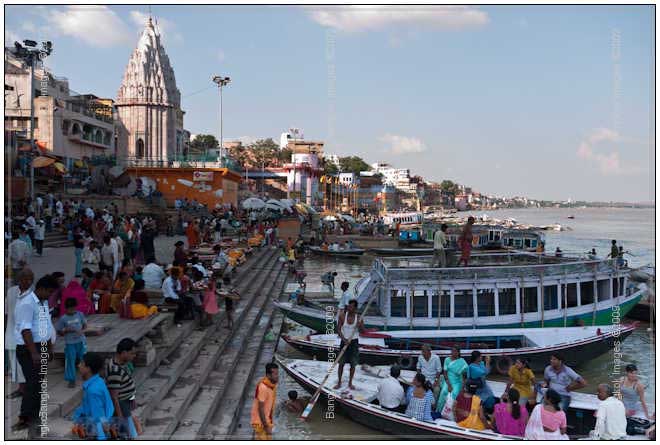
Panasonic Lumix G-1, 28mm, 1/250; f/5.0; ISO100, aperture priority
The lively and colorful Dasaswamedh Ghat, is a bustle of activity in the early evening hours.
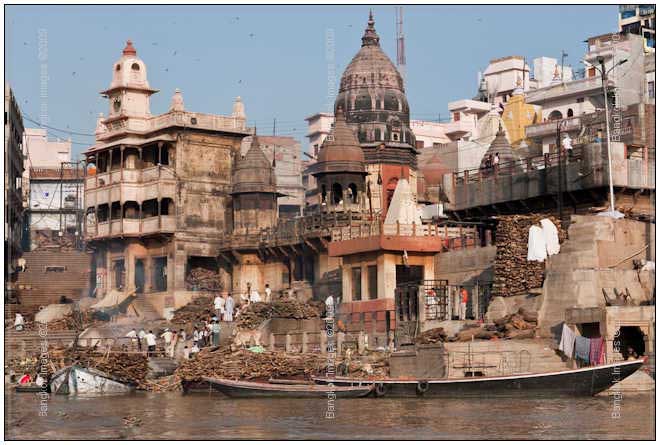
Panasonic Lumix G-1, 78mm, 1/320; f/8.0; ISO100, aperture priority
Manikarnika Ghat, the largest cremation ghat on the bank of the Ganges and as such considered the most auspicious. Corpses are doused in the river prior to cremation. Huge piles of firewood are stacked along the top of the ghat, of which each type has
its own price.
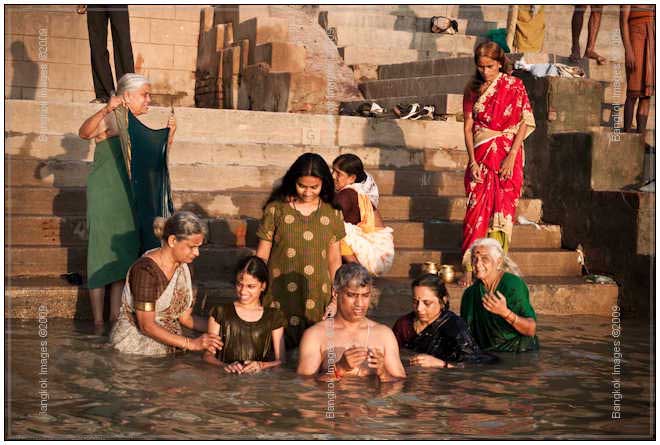
Panasonic Lumix G-1, 66mm, 1/125; f/6.3; ISO100, aperture priority
A family performs a ritual bath in the early hours of the morning.
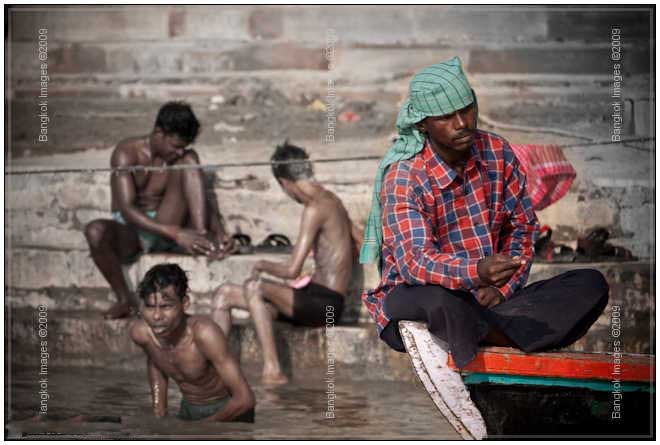
Panasonic Lumix G-1, 310mm, 1/1250; f/5.6; ISO200, aperture priority
A man tries his luck at fishing, using a thin nylon yarn, in the mostly septic waters of the Ganges.
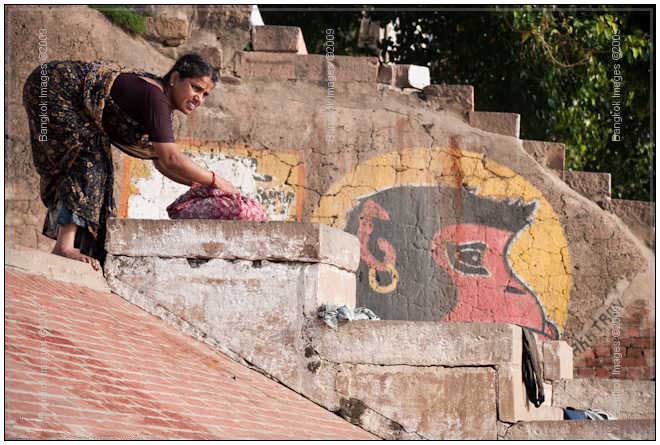
Panasonic Lumix G-1, 166mm, 1/800; f/5.6; ISO200, aperture priority
A woman is busies herself doing laundry on the steps leading to the river.
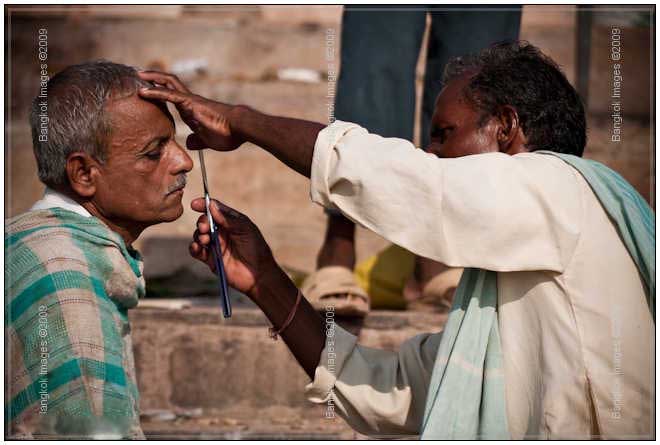
Panasonic Lumix G-1, 228mm, 1/1000; f/5.0; ISO200, aperture priority
Barber and customer by the river.
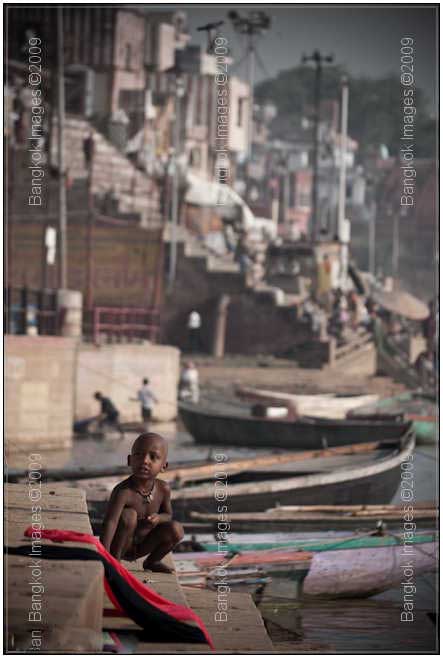
Panasonic Lumix G-1, 288mm, 1/1250; f/5.2; ISO200, aperture priority
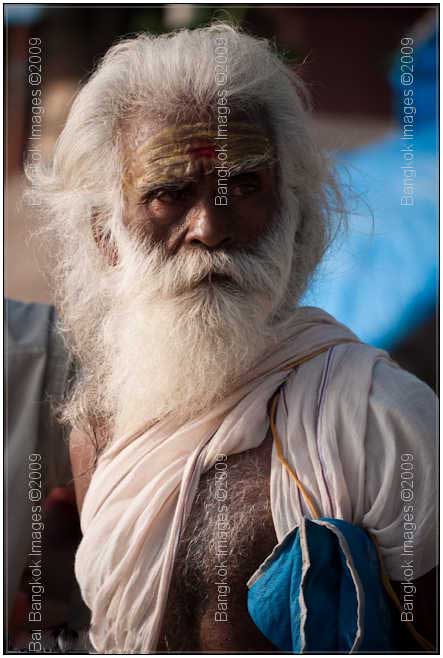
Panasonic Lumix G-1, 342mm, 1/1000; f/5.4; ISO200, aperture priority
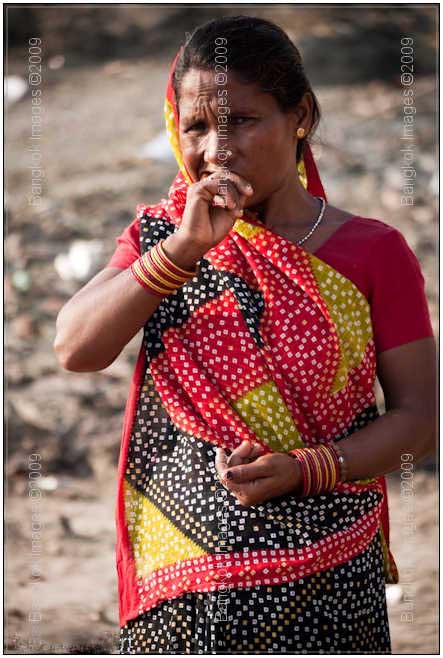
Panasonic Lumix G-1, 294mm, 1/400; f/5.2; ISO200, aperture priority
Many people use the incredibly dirty water to brush their teeth, and some even drink it ceremoniously in an effort to purify their bodies.
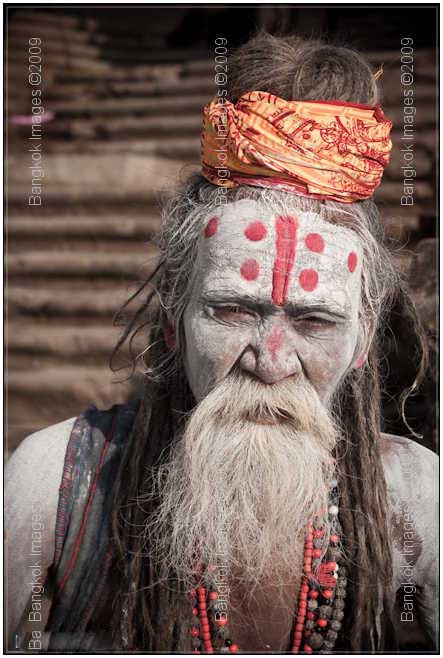
Panasonic Lumix G-1, 90mm, 1/1000; f/5.6; ISO100, aperture priority
A Sadhu (Hindu Holy Man)
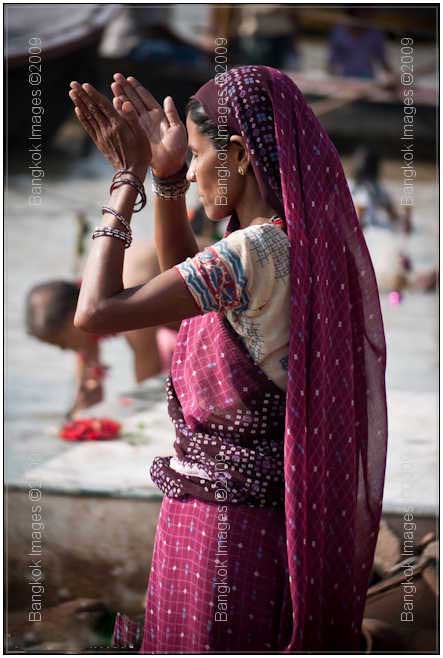
Panasonic Lumix G-1, 310mm, 1/400; f/5.3; ISO200, aperture priority
Praying for salvation
Akulka
Akulka –
These are truly fine photographs! The compositions are rock solid, the subjects engaging, and your processing of the colors and levels spot on. I must say, you've made great strides in both composition and image quality recently. I want to mention
your change to the Micro 4/3's system of a superzoom point and shoot as a major factor of your improved image quality, and it is. But that discounts the real progress you've made in composition and image processing. I can't wait
to see what the next year will bring.
Steve
I suspect the readers submissions will be a highly anticipated section of this column and I encourage anyone with photographs and travel accounts they'd like to share to please send them to me at: QandA@Bkkimages.com
Readers Questions
BKKSteve;
I am going to have my local PC tech build me a new machine. I am considering the new i5 chip and I want to over clock it as much as possible. Do you recommend this?
Great weekly!
Wayne
Wayne –
I think the new i5 and i7 chips introduced last month will make fine image workstations. However, I don't believe over clocking and image processing mix. There are many technical issues far beyond the scope of this column so I won't go into
them here, but I will tell you in the near future I'm going to do a full review on the i7 machine I built a few months back. Its been working flawlessly and is the best PC I've used for image processing. Look for this review within 3-4
weeks.
Steve
Steve:
I was at a computer fair last weekend and I watched a lady draw some very nice portraits using her computer! She had some sort of flat plastic table she drew on with a pen. What she drew immediately appeared on the screen. What is this device and is it
useful for image processing?
Kirby:
Kirby –
What the lady was using is a very common input device called a graphic tablet. There is only one premium tablet on the market and these are from Wacom. (www.wacom.com/intuos) I personally use their Intuos products
and have for years. Not only can they help you quickly navigate around your imaging program like a mouse, but the tablet can be programmed and if set up properly will be much faster and more useful than a mouse. AND it provides a fine control
of the brushes and other Photoshop tools that nothing else can. This item is a must for any serious Photoshop work.
I hope this helps
Steve
Please submit your questions to QandA@Bkkimages.com All questions will be answered and most will show up in the weekly column.
A Snapshot of Bangkok Images Week in Review
Another slow week. However, as I write this I'm making plans for a few weeks on the road which should be very productive. I need to shake off the dust and take to the road. I'll probably be on the road as you read this and I'm not sure
if I'll have the time to complete a full column for the November 7th issue. I'm thinking of a running blog of my travels instead.
Infocus Blog
Safety Nets
One of the big advantages to my workshops is that you get to try a lot of neat gear. If you shoot Canon I probably have all the lenses you're interested in. You can try them out and see if they fit your style and expectations before shelling out
$5000 for that 300mm F2.8 IS.
During one workshop I made my camera case available with about ten lenses inside. The camera case is in the rear of my SUV at approximately hip level. The case itself is a hard plastic case and I always leave one extra lens 'hole' open. This way when switching lenses I can remove the lens on the camera and put it directly in the hole. If you set it on top of the other bags in the back, or somewhere where it can fall, it will fall. If you drop a lens you will break it. How
badly you break it will depend on what part of the lens it falls on, from how high, and on what type of surface. The extra 'hole' in my camera case is my "safety net" for my lenses.
On this day we were going to be walking around a temple so my client selected two rather pricey lenses, and put one on this camera and the other in his knapsack. As we walked around the temple he decided to change lenses and he walked over to a wall and
removed the lens from the knapsack and started to put it on the wall. He forgot his safety net.
He was going to put the lens he wanted to use on the wall, take off the lens on the camera and put it on the wall, and then switch them. Many do this. There would only be a problem if one or both of the lenses fell off the wall somehow. There are more
than a few ways this could happen.
Instead, I showed him how I do it. I carry a small towel in my knapsack or camera bags and kneeling down I put it on the ground, and then put the lens on the towel. The point of this is, if it's already on the ground it can't fall any further.
It's your safety net.
Cameras are expensive and we often save or budget for quite a while to buy our gear. As a professional you can't afford to break your gear during a shoot or at anytime you can't replace it before a shoot. Missing a shoot could well cost you
5-100x what the broken item would cost to replace. So we devise safety nets.
One such safety net for professionals is to always carry redundant gear. Two bodies, and two lenses of each focal length you think you'll need. Two flashes, two light meters, two of anything which can easily break. This is an expensive safety net,
but a very important one. Several times I've had gear fail and once even get stolen while shooting a wedding. Redundant gear allowed me to keep working and complete the assignment.
How about the guys who take expensive photography safaris to Africa or some other exotic location? They save all year and carefully plan this trip of a lifetime. They're going there to take pictures and have a great time doing it. It would really
hurt to get to your destination and have a broken or missing camera. Even as a hobbyist you need to carefully plan around every contingency to ensure your equipment arrives on time and in working order.
This might mean that your safety net is a high end military grade case with dense foam inserts, or theft proof locks to ensure a baggage handler doesn't help her/himself. It might mean not checking certain pieces of your gear and carrying them on
instead. You need to think it through, every possible way things could go wrong, and then plan to make sure they can't go wrong.
With the problems with airline security these days, and many airlines requiring you to either not lock your luggage or to use a "TSA" approved lock that ever baggage handler has
a key to.. there have been times I've shipped my gear ahead via Fedex and placed it on will call instead of risking it on the plane. I have special very tough Milspec cases just for this purpose and Fedex will keep your equipment at the local
office until you go pick it up, or call for it to be delivered. Yes it's expensive, but it's the most reliable safety net I've been able to come up with for really important jobs.
Where do you store your images? When you download the images from your flash memory card what do you do with them? Do you take into account your laptop might get stolen, or it's hard drive fail? I use Lightroom to download my images and it allows
you to save your images to two locations at one. Safety net one.
I download to my laptops hard drive and to an external USB powered drive at the same time. And I keep the images on the CF cards as well. The images are now in three locations. The laptop goes with my carry on bag, but if that gets snatched from my hands
at the airport then I still have my memory cards in my camera case. Safety net two.
I've had assignments where the images are worth more than my equipment, which is why the USB powered hard drive is always on my person and if I get robbed or have to let go of something.. the USB drive will still be in my pocket. Safety net three.
And if by some fluke I lose my laptop bag, my camera cases, and the USB hard drive bumps something during the robbery and fails then what? Hopefully I paid a bit extra for a hotel room with a high speed connection and before going to bed the night before
I uploaded the images to my personal FTP and they're already safe and sound at home. Safety net four.
The long and laborious point I'm trying to make is that it's prudent to try and anticipate everything which can fail, get stolen, get lost, or just go wrong. It will save you expensive equipment, priceless images, or perhaps even your reputation.
There's a properly sized appropriately priced safety net for everyone.
Until next time..



